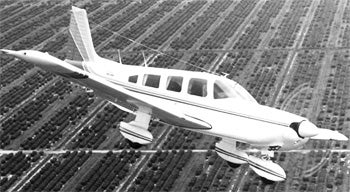 |
| STANDARD DATA: (260) Seats 6-7. Gross wt. 3,400. Empty wt. 1,779. Fuel capacity 84. Engine 260-hp Lycoming. PERFORMANCE: Top mph 170. Cruise mph 158. Stall mph 63. Initial climb rate 775. Ceiling 12,800. Range 828. Takeoff distance (50') 1,800. Landing distance (50') 1,000. STANDARD DATA: (300) Seats 6-7. Gross wt. 3,400. Empty wt. 1,846. Fuel capacity 84. Engine 300-hp Lycoming. |
The big Six is a prodigious people packer. Resembling a stretched version of the basic Cherokee airframe, it provides slight twin performance with single-engine economy. The Six was introduced in 1965 with a 260-hp engine, which some pilots seem to feel was not quite enough power. So the people at Piper decided to offer the option of the 300-hp powerplant up front in 1970. Basically a six-seater, the largest of the Cherokees is easily converted to handle a large amount of cargo loaded through its spacious rear double doors; thus it performs as a double-duty passenger utility airplane. Besides the standard six-seat arrangement with center aisle, there is a seventh-seat option.
In 1978, increased speeds of 7 mph made the Cherokee Sixes the fastest planes in their class. A 5% increase in range is also a product of overall drag reductions, a refined powerplant, and new Piper-engineered speed fairings. In 1979, the single-engine workhorse was fitted with a 98-galIon capacity fuel tank and structurally integrated fuel system popularized by the Lance. The new fuel system increased the Six's range by over 100 miles at many power settings. At 65% best power, the Six's range is 923 miles.

Subscribe to Our Newsletter
Get the latest Plane & Pilot Magazine stories delivered directly to your inbox





